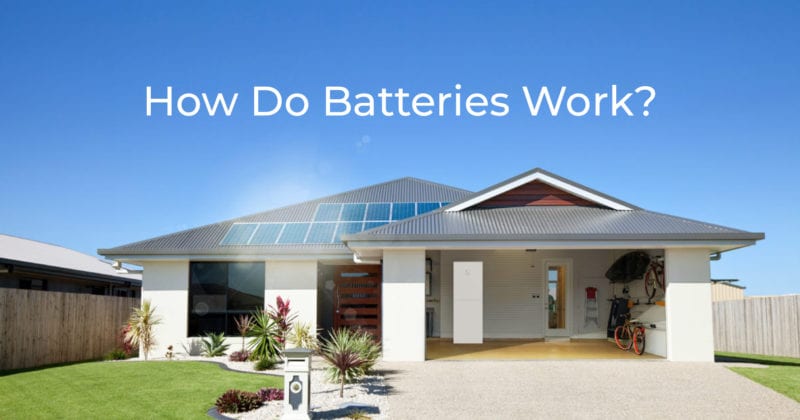How Do Solar Batteries Work?

A solar battery is a battery that stores energy from a solar PV system. The system’s panels absorb energy from the sun and convert it to electricity which then passes through the inverter for your home to use. A battery is an additional component that can allow you to store energy produced from your panels and use the energy at a later time, such as in the evening when your panels are no longer producing energy.
Unless you have an off-grid system, your solar PV system is connected to the electricity grid, which allows your home to continue to receive electricity if your panels aren’t producing enough to meet your energy demands. When your system production is more than your energy consumption, the excess energy gets sent back to the grid, this is a process called “net-metering”. When this happens, you will get a credit on your next electricity bill which will reduce your payment amount.
But for those who are off-grid or would rather store the excess energy themselves instead of sending it back to the grid, solar batteries can be a great addition to their solar PV system.
How Does Solar Battery Storage Work?
As mentioned previously, excess energy from you solar PV system is deposited into the battery. This means that the energy surplus can be stored in it and is readily onsite for you to draw from when your solar panels aren’t generating enough electricity.
When choosing the type of battery to use for energy storage, consider the following:
- Battery life and warranty
- Power capacity
- Depth of discharge (DoD)
A battery’s lifespan is generally somewhere from five to 15 years, although it is expected to increase significantly to keep up with the growth of solar panels through the years. Warranties for batteries are generally stated in years or cycles, for example, the sonnenBatterie has a warranty of 10 years or 10,000 cycles (whichever comes first).
The power capacity refers to the total amount of electricity that the battery can keep. Solar batteries are usually stackable, meaning you can have multiple battery storages at home to increase capacity.
The DoD measures the degree to which a battery can be used relative to its total capacity. If a battery has a 100% DoD it means you can use the full battery storage amount (e.g. 2.5kWh) to power your home. If a battery has a 94% DoD, it means you can use up to 94% of the battery capacity (e.g. for a 2.5kWh battery, you can use down to 2.35kWh before the battery needs to charge again).
Common Solar Battery Types
- Lithium Ion
For the most reliable lifespan and DoD, your best choice for your home battery would be Lithium ion. Majority of new home battery storage uses this technology, as they have a longer lifespan and higher DoD. Lithium ion batteries are also more compact, although they’re more expensive compared to lead acid batteries. Examples of lithium ion batteries include the sonnenBatterie and Tesla Powerwall's.
- Lead acid
Lead acid batteries have been used for decades and are one of the cheapest varieties in home energy storage for off-grid power systems. The downfall to buying this type of technology is that it is becoming outdated and has a lower DoD compared to other battery types.
Benefits of Battery Storage
Having battery storage lets you become more energy independent. Batteries maximise your solar self-consumption, reducing the amount of electricity you need to purchase from the grid. They also allow your home to continue using solar power of an evening by storing the excess solar energy produced during the day so that it is readily available to use when you need it.
On a larger scale, batteries can help balance short-term power fluctuations, manage peak demand and act as a backup to prevent or recover from power outages affecting an entire gridline. Installing energy storage solutions also impact the supply and demand of renewable energy. Cleaner energy sources can be integrated easier into the electricity ecosystem when energy storage solutions are developed and can give us more flexibility in producing and using electricity.
A solar battery is not necessarily suitable to be paired with all solar PV systems. Firstly, you need to ensure your system is compatible with having a battery added to it, and if you’re looking to add a battery to further reduce your electricity bills, you will need to ensure your system is producing enough excess energy to charge the battery once it has delivered the on-going daily energy demand to your home. If not, you may need to consider increasing your solar PV capacity to provide the required excess energy.
If you would like further information on whether battery storage is suitable for your situation, contact us today.


